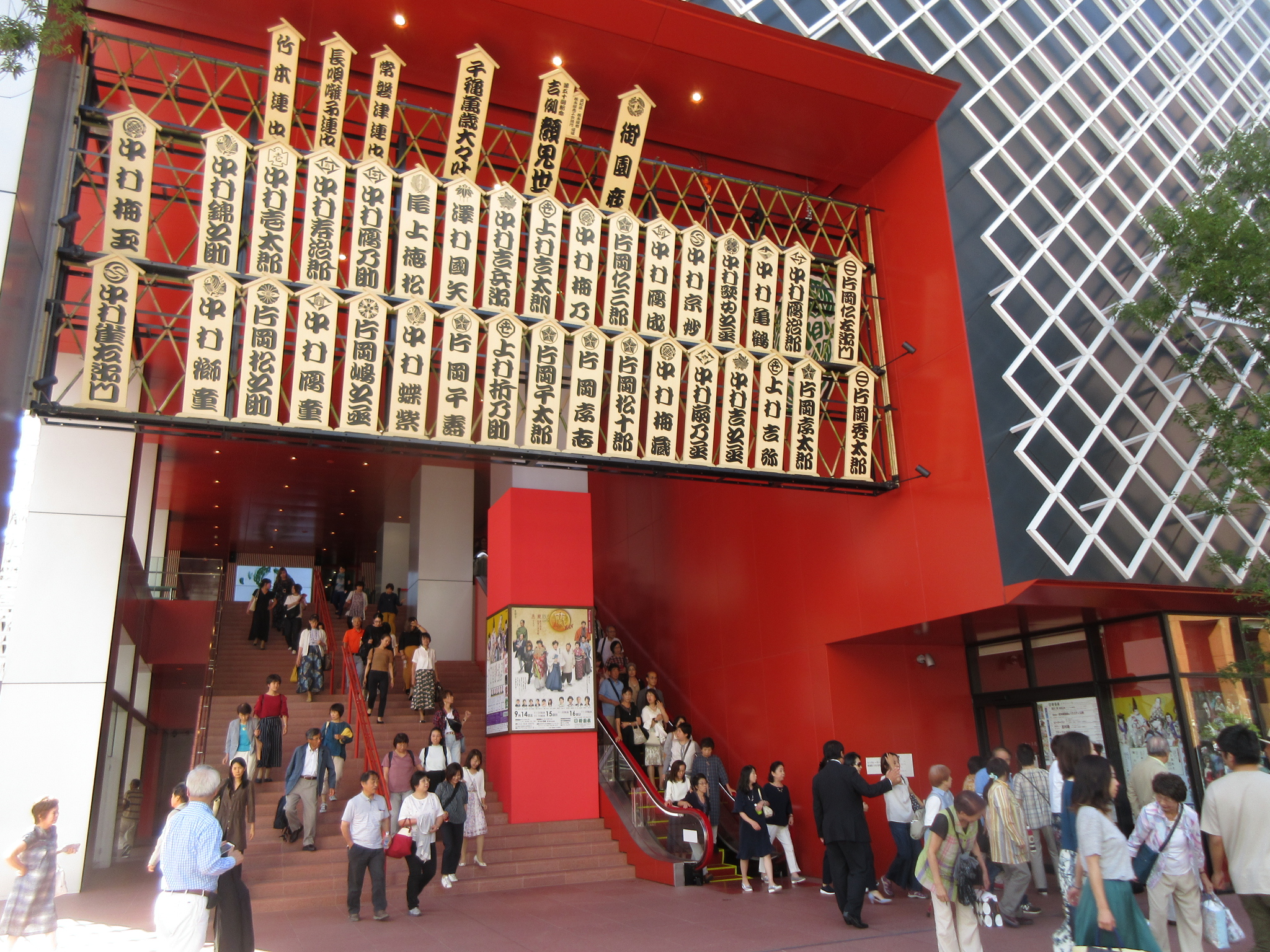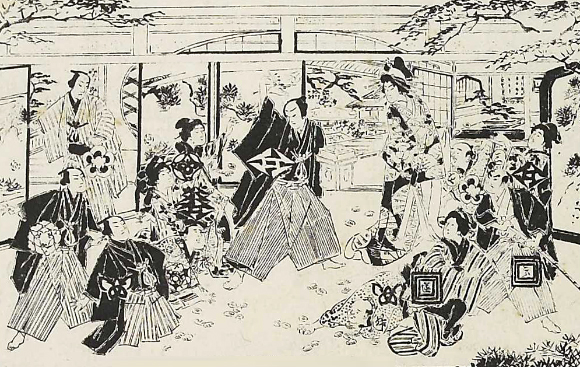|
Misono-za Nagoya March 2013 (5)
The is a theatre in the city of Nagoya, central Japan. It was originally constructed in 1800s and presents ''kabuki'' and Western stage plays. History The tradition of ''kabuki'' in Nagoya goes back to the Edo period. With the opening of Japan to the West in the Meiji era, the Japanese wooden structure was replaced with a permanent building that was constructed out of brick and mortar in the Western Renaissance style in 1895. This structure was enlargened by the 1920s with a pillared porch added to the front. The old theatre was destroyed during the bombing of Nagoya in World War II. The new structure was constructed in the 1970s. A number of curtains, called ''doncho'', were designed for the theatre. The artist Kataoka Tamako designed one of the curtains called "Flowers at Mount Fuji" (富士に献花), which was sponsored by Matsuzakaya. Downstairs there are a number of restaurants open for customers during the break. The last performance was given in March 2013 followi ... [...More Info...] [...Related Items...] OR: [Wikipedia] [Google] [Baidu] |
Shūmei
''Shūmei'' (, "name succession") are grand naming ceremonies held in kabuki theatre. Most often, a number of actors will participate in a single ceremony, taking on new stage-names. These stagenames, most often those of the actor's father, grandfather, or teacher, are passed down between generations of actors' lineages, and hold great honor and importance. Many names are associated with certain roles or acting styles, and the new possessor of each name must live up to these expectations; there is the feeling almost of the actor not only taking a name, but embodying the spirit, style, or skill of each actor to previously hold that name. Many actors will go through at least three names over the course of their career, their participation in a ''shūmei'' representing their passage into a new chapter of their performing career. The ''shūmei'' usually is followed by a performance significant to the actors' new names; these might involve larger parts, a new play, or roles traditiona ... [...More Info...] [...Related Items...] OR: [Wikipedia] [Google] [Baidu] |
Theatres In Nagoya
Theatre or theater is a collaborative form of performing art that uses live performers, usually actors or actresses, to present the experience of a real or imagined event before a live audience in a specific place, often a stage. The performers may communicate this experience to the audience through combinations of gesture, speech, song, music, and dance. Elements of art, such as painted scenery and stagecraft such as lighting are used to enhance the physicality, presence and immediacy of the experience. The specific place of the performance is also named by the word "theatre" as derived from the Ancient Greek θέατρον (théatron, "a place for viewing"), itself from θεάομαι (theáomai, "to see", "to watch", "to observe"). Modern Western theatre comes, in large measure, from the theatre of ancient Greece, from which it borrows technical terminology, classification into genres, and many of its themes, stock characters, and plot elements. Theatre artist Patrice ... [...More Info...] [...Related Items...] OR: [Wikipedia] [Google] [Baidu] |
Kabuki Theatres
is a classical form of Japanese dance-drama. Kabuki theatre is known for its heavily-stylised performances, the often-glamorous costumes worn by performers, and for the elaborate make-up worn by some of its performers. Kabuki is thought to have originated in the very early Edo period, when founder Izumo no Okuni formed a female dance troupe who performed dances and light sketches in Kyoto. The art form later developed into its present all-male theatrical form after women were banned from performing in kabuki theatre in 1629. Kabuki developed throughout the late 17th century and reached its zenith in the mid-18th century. In 2005, kabuki theatre was proclaimed by UNESCO as an intangible heritage possessing outstanding universal value. In 2008, it was inscribed in the UNESCO Representative List of the Intangible Cultural Heritage of Humanity. Etymology The individual kanji that make up the word ''kabuki'' can be read as , , and . ''Kabuki'' is therefore sometimes translate ... [...More Info...] [...Related Items...] OR: [Wikipedia] [Google] [Baidu] |
Buildings And Structures In Japan Destroyed During World War II
A building, or edifice, is an enclosed structure with a roof and walls standing more or less permanently in one place, such as a house or factory (although there's also portable buildings). Buildings come in a variety of sizes, shapes, and functions, and have been adapted throughout history for a wide number of factors, from building materials available, to weather conditions, land prices, ground conditions, specific uses, prestige, and aesthetic reasons. To better understand the term ''building'' compare the list of nonbuilding structures. Buildings serve several societal needs – primarily as shelter from weather, security, living space, privacy, to store belongings, and to comfortably live and work. A building as a shelter represents a physical division of the human habitat (a place of comfort and safety) and the ''outside'' (a place that at times may be harsh and harmful). Ever since the first cave paintings, buildings have also become objects or canvasses of much artistic ... [...More Info...] [...Related Items...] OR: [Wikipedia] [Google] [Baidu] |
Minami-za
is the primary kabuki theatre in Kyoto, Japan. It was founded in 1610 as . The current building, with a 1,086 seat capacity, was built in 1929. History The Minami-za is one of the earliest of the seven officially-licensed kabuki theatres built in the early Edo period (1615-1623) in the Shijo Kawara area in Kyoto; the theatre pre-dates those of Tokyo and Osaka. The current Minami-za theatre was built in 1929 in the architectural style of the Momoyama period, with a gabled roof and a traditional turret marking the official approval of the government. In 1991, after the end of the Shōwa period Shōwa may refer to: * Hirohito (1901–1989), the 124th Emperor of Japan, known posthumously as Emperor Shōwa * Showa Corporation, a Japanese suspension and shock manufacturer, affiliated with the Honda keiretsu Japanese eras * Jōwa (Heian ..., the interior was drastically refurbished and modern stage mechanism was installed. In 1996, the Minami-za was registered as a Japanese Tan ... [...More Info...] [...Related Items...] OR: [Wikipedia] [Google] [Baidu] |
Kabuki-za
in Ginza is the principal theater in Tokyo for the traditional ''kabuki'' drama form. History The Kabuki-za was originally opened by a Meiji era journalist, Fukuchi Gen'ichirō. Fukuchi wrote kabuki dramas in which Ichikawa Danjūrō IX and others starred; upon Danjūrō's death in 1903, Fukuchi retired from the management of the theater. The theater is now run by the Shochiku Corporation which took over in 1914. The original Kabuki-za was a wooden structure, built in 1889 on land which had been either the Tokyo residence of the Hosokawa clan of Kumamoto, or that of Matsudaira clan of Izu. The building was destroyed on October 30, 1921, by an electrical fire. The reconstruction, which commenced in 1922, was designed to "be fireproof, yet carry traditional Japanese architectural styles", while using Western building materials and lighting equipment. Reconstruction had not been completed when it again burned down during the 1923 Great Kantō earthquake. Rebuilding was finall ... [...More Info...] [...Related Items...] OR: [Wikipedia] [Google] [Baidu] |
Suehiro-za (Nagoya)
The Suehiro-za (末広座) was a ''kabuki'' theatre in Nagoya, central Japan. It was located in Suehiro-chō. History In Nagoya of the Meiji era at that time a number of theatres existed, such as the Chitose-za (千歳座) in Minamikuwana-machi (南桑名町), Shinmori-za (新守座) in Motoshige-chō (本重町), Onu-za (音羽座) in Minamifushimi-chō (南伏見町), Hoso-za (宝生座) in Ōsu, and Misono-za. The theatre was founded under a different name originally in January 1883. Among the many noted actors were Nakamura Denkurō VI (1859-1923), who was born in Suehiro-chō and became of a member of the children actors troupe at the Suehiro-za. Ichikawa Chūsha VII (1860-1936) and Ichikawa Danzō VII (1836-1911) appeared together in May 1909, as well as Nakamura Tokizō III (1895-1959) appeared here in May 1917. The building was bought by Shochiku, a cinema chain which has its roots in ''kabuki'' production, and converted into a movie theatre in 1927. Under its new ... [...More Info...] [...Related Items...] OR: [Wikipedia] [Google] [Baidu] |
Kuma Kengo
is a Japanese architect and professor in the Department of Architecture (Graduate School of Engineering) at the University of Tokyo. Frequently compared to contemporaries Shigeru Ban and Kazuyo Sejima, Kuma is also noted for his prolific writings. He is the designer of the Japan National Stadium in Tokyo, which was built for the 2020 Summer Olympics. Early life and education Kuma was born in Kanagawa, and attended Eiko Gakuen Junior and Senior High School. After graduating in Architecture from the University of Tokyo in 1979, he worked for a time at and . He then moved to New York City for further studies at Columbia University as a visiting researcher from 1985 to 1986. Career In 1987, Kuma founded the Spatial Design Studio, and in 1990, he established his own firm, Kengo Kuma & Associates. He has taught at Columbia University, the University of Illinois at Urbana-Champaign, and Keio University, where in 2008, Kuma was awarded a Ph.D. degree in architecture. As a professor at ... [...More Info...] [...Related Items...] OR: [Wikipedia] [Google] [Baidu] |
Namako Wall
''Namako'' wall or ''Namako-kabe'' (sometimes misspelled as ''Nameko'') is a Japanese wall design widely used for vernacular houses, particularly on fireproof storehouses by the latter half of the Edo period. The ''namako'' wall is distinguished by a white grid pattern on black slate. Geographically, it was most prominent in parts of western Japan, notably the San'in region and San'yō region and, from the 19th century, further east, in the Izu Peninsula. Origin As the base of the external walls of earthen ''kura'' storehouses is vulnerable to physical damage and damage from rain, they are often tiled to protect them. The exaggerated white clay joints that are a few centimetres wide and rounded on top remind people of ''namako'' sea cucumber. Modern uses During the Meiji period (1868–1912), when Japan imported many Western ideas, the ''namako'' wall was used in a way that mimicked the "bricks and mortar" style of these countries. For example, Kisuke Shimizu's Tsukiji Hotel f ... [...More Info...] [...Related Items...] OR: [Wikipedia] [Google] [Baidu] |
Chunichi Theatre
was a venue for the performing arts in Nagoya, Aichi Prefecture, Japan. It closed on March 25, 2018. The theatre was located inside the Chunichi Building. Performances such as kabuki and musicals were shown there. See also *Aichi Arts Center *Misono-za The is a theatre in the city of Nagoya, central Japan. It was originally constructed in 1800s and presents ''kabuki'' and Western stage plays. History The tradition of ''kabuki'' in Nagoya goes back to the Edo period. With the opening of ... References External links * Concert halls in Japan Theatres in Nagoya Tourist attractions in Nagoya Former theatres in Japan {{Japan-theat-struct-stub ... [...More Info...] [...Related Items...] OR: [Wikipedia] [Google] [Baidu] |
Matsuzakaya
( TYO: 8235, delisted) is a major Japanese department store chain operated by Daimaru Matsuzakaya Department Stores, a subsidiary of J. Front Retailing. When the chain was an independent company, , it had its headquarters in Naka-ku, Nagoya. History Established in 1611 in Nagoya by , it is one of the oldest department stores in the world. It was initially a modest wholesale manufactory of silk kimono and Japanese lacquerware. In 1736 the company expanded its business to the retail sale of cotton and linen kimono. A second store was opened in Kyoto in 1745. The old capital was at that time the only region producing high-quality kimono. The store in Ueno at Shitaya Hirokoji was depicted in an ukiyo-e print from ''One Hundred Famous Views of Edo'' by Hiroshige II in 1856. With the industrialisation during the Meiji era, Matsuzakaya store was changed in 1910 to a western-style department store. In 1924, its Ginza branch became the first department store in Japan where c ... [...More Info...] [...Related Items...] OR: [Wikipedia] [Google] [Baidu] |






